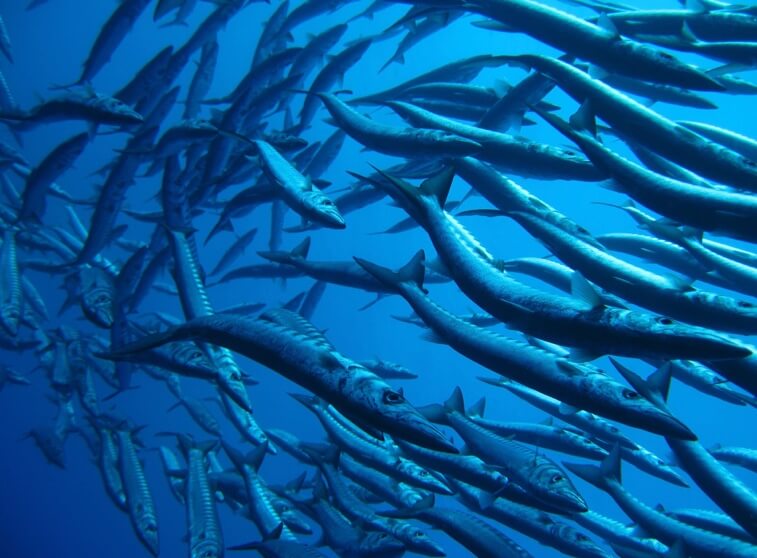Fish, for many people across the globe, is a vital food source. However, not all species of fish are necessarily edible; this has not stopped people from trying to find ways to eat them anyway! One group of fish that’s surrounded in much debate is the barracuda. So, are barracuda edible?
You can eat a barracuda, but many people would advise otherwise. You should only eat those fish that are smaller than 3.5 feet or 4.5 pounds. Larger fish are potentially poisonous to humans, as they carry higher amounts of ciguatera, a naturally occurring toxin, through bioaccumulation.
Okay, so barracuda are back on the menu! But why do people steer clear of them, are there particular ways or signs to identify which barracuda are safer to eat? Are they even worth the effort?
Differences In Barracuda Edibility Explained
Why are some barracuda edible while others are not?
Well, the answer to this question is actually based in the ecology of the barracuda.
Barracuda is the name given to a few species of predatory fish belonging to the Sphyraena genus. Predatory in that they hunt down other fish to eat. Not a very surprising fact when you consider what the teeth of a barracuda look like!
It is within this eating of other fish that our “problem” lies. Depending on the type of fish that the barracuda eats will increase the likelihood of whether or not they carry the naturally occurring toxin ciguatera.
According to eMedicineHealth, ciguatera is “a foodborne illness (food poisoning) caused by eating fish that is contaminated by ciguatera toxin. Ciguatera toxin is a heat-stable lipid-soluble compound, produced by dinoflagellates and concentrated in fish organs, that can cause nausea, pain, cardiac, and neurological symptoms in humans when ingested.”
These dinoflagellates are protists found in the ocean (and in freshwater), are part of the plankton found there, and therefore form the basis of many marine food chains.
Reef fish eat these dinoflagellates (either directly or through different sources, e.g., algae that the dinoflagellates “rest” on) and are then, in turn, eaten by predatory fish such as barracuda.
After eating many reef fish, large barracuda are “infected” with these single-celled organisms. This is the process of bioaccumulation (the buildup and increase in the concentration of chemical or organic compounds through the trophic levels).
Mercury is another compound that can accumulate to dangerous levels through the trophic levels in fish (this can be found in barracuda as well).
This toxin is odorless, colorless and cannot be removed through cooking.
So why are smaller fish okay?
The reality is that small or large, barracuda and other predatory fish (including grouper, red snapper, eel, amberjack, sea bass, and Spanish mackerel) can carry ciguatera; however, the smaller the barracuda, the smaller the concentration of the toxin. I.e., smaller barracuda have eaten less fish and therefore have less of the toxin ingested.
Although not completely safe to eat, you are less likely to be poisoned when eating a smaller (less than 4.5pounds) barracuda.
Another factor to consider is where the fish was caught. If the fish was around a shoreline or reef, the chances of poisoning are higher than fish caught out at sea. However, this is NOT a hard and fast rule because barracuda are known for traveling distances in search of food.
How Do You Know If A Barracuda Is Poisonous Or Not?
Although there are many myths and urban legends for when it comes to “testing” whether or not a barracuda can give you ciguatera poisoning or not, the reality is, you cannot actually tell. While poisonous to humans, the toxin does not affect the fish itself.
More importantly would be to assume that all barracuda are “contaminated” and making a decision to eat or not from there. As discussed previously, smaller barracudas, although not completely without the toxin, will, in theory, have less of a concentration, so the size of the fish in question is a good starting point. Anything less than three and a half feet or less than four and a half pounds are a good guideline.
The majority of ciguatera cases are from the regions of the Caribbean Sea, Hawaii and the coast of Central America, so any fish from these areas should be treated with more caution.
(note, ciguatera poisoning is not limited to these areas, it is found worldwide, especially in the Pacific Ocean, the West Indies, and the Indian Ocean).
If you have eaten barracuda, don’t fret, the majority of ciguatera poisoning cases are not life-threatening, with symptoms starting roughly between six and eight hours after consumption. There have, however, been cases of symptoms taking as long as twenty-four hours or as little as two hours until onset.
These symptoms include:
- Nausea
- Vomiting
- Diarrhea
- Abdominal pain
- Muscle pain
- Numbness
- Tingling
- Dizziness
- Vertigo
- Headache
- The reversal of the hot and cold sensation
- Your teeth may feel loose
- Itchy skin
These symptoms usually last for a couple of days but can last up until four weeks in some cases.
In severe cases, symptoms can include:
- Shortness of breath
- Salivation
- Tearing
- Chills
- Rashes
- Itching
- Paralysis
In particularly bad cases, poisoning from ciguatera toxins can result in nerve or cardiovascular damage or even death. Death is rare however, at less than 0.5% of all cases.
There is no antidote for ciguatera poisoning/toxin. Doctors will instead treat the symptoms as well as complications while allowing the body to heal itself.
Should You Eat Barracuda?
Just because you CAN eat barracudas (under three and a half feet long, or 4.5 pounds in weight), does it mean you SHOULD eat them?
The reality is, many people will say yes. They taste great; they are a good source of protein, they are not over-fished for consumption, and for the most part, they are safe (depending who you ask).
So why then do some government agencies place them on “Do not eat” lists?
Even though it is reduced, there IS still a risk of becoming badly sick; because of this and the many lawsuits that would follow, Government policy needs to take the standpoint against consuming something that will potentially make you sick.
In terms of statistics, the likelihood of contracting ciguatera poisoning from barracuda is quite low, with between five and seventy cases per ten thousand people per year, according to the Louisiana Department of Health and Hospitals.
The truth is, ciguatera toxin is not limited to barracudas. There are around 500 species of fish in the “at-risk” category, including fish like grouper and mackerel.
More importantly is which part of the fish you are consuming. Toxins have specific places where they build up in the fish’s body. The liver is the main source, followed by the intestines (or viscera), the gonads (testes and ovaries), and finally, the flesh (the part we are interested in).
When ordering or selecting pieces of fish that stand a higher risk of exposing you to the ciguatera toxin, try and avoid those above-mentioned fish parts (aside from the flesh), as this should reduce the risk of ingesting greater amounts of the toxin.
Ultimately the choice is yours when it comes to eating barracudas or not. The likelihood is low that you will be poisoned (especially if you choose smaller fish). However, there is still a chance of it.
Related Articles
Conclusion
We humans have a knack for eating strange and wonderful things. My philosophy is to try as many different types of food as possible, but if barracudas are not something you’d like to try, don’t worry; there are still plenty of fish in the sea! If you do decide, be safe and remember, bigger is NOT better in this regard.

